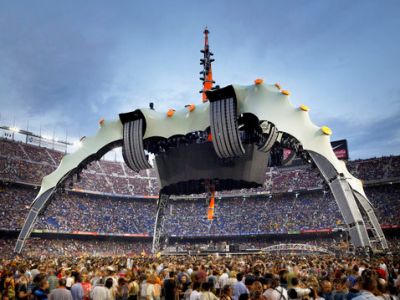
Trendsetting hydraulics application for U2 stage
Product News Friday, August 21, 2009: Enerpac
The Belgian company Stageco has constructed three gigantic, identical stages for the current U2 360 Tour. What makes this project special, is that high-pressure hydraulics are being used for the first time ever to assemble and dismantle the 230 ton construction - also known as "the claw". Together with Enerpac, Stageco has developed a unique system, based on Enerpac's Synchronous Lift System, to raise the modular construction to a height of 30 metres quickly and safely.
Being able to put on bigger and better shows than your competitors gives you a trump card in the entertainment world. Performances and tours by famous artists and bands have to look good, as is demonstrated by the glitz and special effects that are usually the main feature. The stage is crucial, and this is no different in U2 360 Tour. For this world tour, set designer Willy Williams and stage architect Mark Fisher came up with "the claw", a 30 metre high stage construction on four legs, giving spect ators all around the stage an unobstructed view of the band.
Leap frogging
Stageco, a specialist company based in Tildonk, Belgium, was contacted for the construction of the stage. This was not the first time Stageco also designed and built the stages for one of previous tours, the PopMart Tour in 1997. Stageco is an undisputed market leader and primarily sets itself apart through customisation. Over the years, the company has built stages for tours by artists such as the Rolling Stones, Bon Jovi, Tina Turner, Elton John and Johnny Hallyday. Stageco provides a complete package, from technical design and manufacture, right up to logistics. Since there is only a relatively short time between performances and a total of 7 to 8 days are needed to assemble and dismantle the stage construction, three whole stages have been constructed, which are used following the leap frogging principle: one is used for the show, whilst the second is already being built at the next location and the third is being dismantled at the previous location.
Speed
One of the construction requirements was that the stage could be built and taken down again in a relatively short time. The challenge for Stageco was therefore how to assemble and dismantle the massive 230 ton construction each time. Logistics naturally also needed to be considered and a solution had to be found for the installation of the technics (light and sound) and the special 60 ton video screen that also had to be raised and lowered each time. Chain hoists and winches are normally used for stages, with the support of relatively light mobile cranes where required. However, the load in this project was so great that a different solution was called for. One o f the alternatives considered was the use of extremely heavy mobile cranes with a lifting capacity of at least 400 to 500 tons. However, there was doubt as to whether such cranes would fit inside the stadiums where the concerts were due to take place and whether they could be stabilised sufficiently. The use of such cranes is also very expensive. Another alternative was a temporary hoisting construction and the use of hydraulics, for example, hydraulic strand jacks. Stageco eventually joined up with Enerpac as a source of new ideas and a customisation-oriented partner. The requirement was that the system had to be more or less plug and play. A ready-to-use hydraulic unit was required that would only need to be connected to the electricity supply and the operating computer. Together, the two companies came up with a highly effective solution which incorporated Enerpacï's custom designed Synchronous Lift System to use high-pressure hydraulics for the first time ever for such heavy loads.
